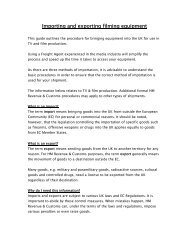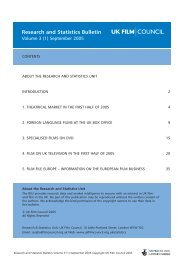The Economic Impact of the UK Film Industry - BFI - British Film ...
The Economic Impact of the UK Film Industry - BFI - British Film ...
The Economic Impact of the UK Film Industry - BFI - British Film ...
You also want an ePaper? Increase the reach of your titles
YUMPU automatically turns print PDFs into web optimized ePapers that Google loves.
<strong>Economic</strong> Contribution <strong>of</strong> <strong>the</strong> <strong>UK</strong> <strong>Film</strong> <strong>Industry</strong><br />
July 2007<br />
<strong>the</strong> rental market for films was £340 million, <strong>of</strong> which <strong>UK</strong> films accounted for about £57 million (17%).<br />
Sales <strong>of</strong> DVDs <strong>of</strong> feature films in 2006 earned £1,556 million, <strong>of</strong> which <strong>UK</strong> films accounted for £296<br />
million (19%). If <strong>the</strong> 30% premia for <strong>UK</strong> films holds for <strong>the</strong>se media, <strong>the</strong> cultural value film-watchers place<br />
on seeing a <strong>UK</strong> film is worth an additional £105 million a year. In addition, <strong>the</strong>re will be cultural value<br />
associated with <strong>the</strong> showing <strong>of</strong> <strong>UK</strong> films on TV.<br />
Box 8-1: Fur<strong>the</strong>r details on our estimation <strong>of</strong> <strong>the</strong> cultural value <strong>of</strong> <strong>UK</strong> film<br />
To estimate <strong>the</strong> private cultural value <strong>of</strong> <strong>UK</strong> film, we have used data from <strong>the</strong> <strong>UK</strong> <strong>Film</strong> Council’s database.<br />
This contains information on each film released in <strong>the</strong> <strong>UK</strong>. <strong>The</strong> data recorded include <strong>the</strong> film’s release<br />
date, distributor, certificate, country <strong>of</strong> origin, language and genre. <strong>The</strong> database also includes financial<br />
information on each film’s box <strong>of</strong>fice takings (to date and on <strong>the</strong> opening weekend) in <strong>the</strong> <strong>UK</strong> and United<br />
States. Data are also available on each film’s advertising spend in <strong>the</strong> <strong>UK</strong>.<br />
Regression analysis<br />
Our initial approach is to investigate a statistical relationship between film j’s box <strong>of</strong>fice receipts in <strong>the</strong> <strong>UK</strong><br />
(BOj<strong>UK</strong>), its box <strong>of</strong>fice receipts in <strong>the</strong> US in sterling (BOjUS) and a dummy variable taking <strong>the</strong> value 1 if it is<br />
<strong>of</strong> <strong>UK</strong> origin (<strong>UK</strong> <strong>Film</strong>j) and zero if from elsewhere. A film’s box <strong>of</strong>fice receipts in <strong>the</strong> US (BOjUS) is included<br />
to control for its general appeal to cinema audiences. A film’s appeal is made up <strong>of</strong> many attributes<br />
including its stars, <strong>the</strong> director, plot, reviews and ratings, awards etc. This leaves <strong>the</strong> dummy variable <strong>UK</strong><br />
<strong>Film</strong>j to potentially capture <strong>the</strong> extra box <strong>of</strong>fice revenue <strong>UK</strong> audiences pay to see an indigenous film.<br />
(1) ln( BO j<strong>UK</strong> ) = α + β * <strong>UK</strong> <strong>Film</strong> j + δ * ln( BO jUS )<br />
A problem with this approach is that if <strong>UK</strong> audiences have a preference for watching indigenous films,<br />
<strong>the</strong>n so might US audiences. If true, <strong>the</strong> US box <strong>of</strong>fice earnings <strong>of</strong> a <strong>UK</strong>-made film will understate its<br />
general appeal. This is liable to bias <strong>the</strong> estimates <strong>of</strong> <strong>the</strong> β coefficient in Equation 1 upwards. We<br />
<strong>the</strong>refore expand <strong>the</strong> model by modifying <strong>the</strong> equation for <strong>UK</strong> box <strong>of</strong>fice receipts and adding ano<strong>the</strong>r for<br />
US ticket sales:<br />
(2) ln( BO j<strong>UK</strong> ) = α + β * <strong>UK</strong> <strong>Film</strong> j + δ * ln( <strong>UK</strong> <strong>Film</strong> j * exp( γ ) * BO jUS + ( 1−<br />
<strong>UK</strong> <strong>Film</strong> j ) * BO jUS )<br />
(3) BO ) = ς + γ * US <strong>Film</strong> + µ * ln( <strong>UK</strong> <strong>Film</strong> / exp( β ) * BO + ( 1 −<strong>UK</strong><br />
<strong>Film</strong> ) * BO )<br />
ln( jUS<br />
j<br />
j<br />
j<strong>UK</strong><br />
j j<strong>UK</strong><br />
<strong>The</strong> objective <strong>of</strong> this system <strong>of</strong> equations is to <strong>the</strong> adjust box <strong>of</strong>fice revenue <strong>of</strong> each film to reflect its<br />
general appeal, ignoring each country’s audiences’ preference for indigenous films. <strong>The</strong> US box <strong>of</strong>fice<br />
receipts for <strong>UK</strong>-made films in Equation 2 are <strong>the</strong>refore scaled upwards by <strong>the</strong> premia US audiences pay<br />
to see US-made films (γ). Similarly, <strong>the</strong> <strong>UK</strong> box <strong>of</strong>fice receipts <strong>of</strong> <strong>UK</strong>-made films are adjusted downward in<br />
Equation 3 by <strong>the</strong> premia (β) <strong>UK</strong> audience pay to see an indigenous film.<br />
52

















